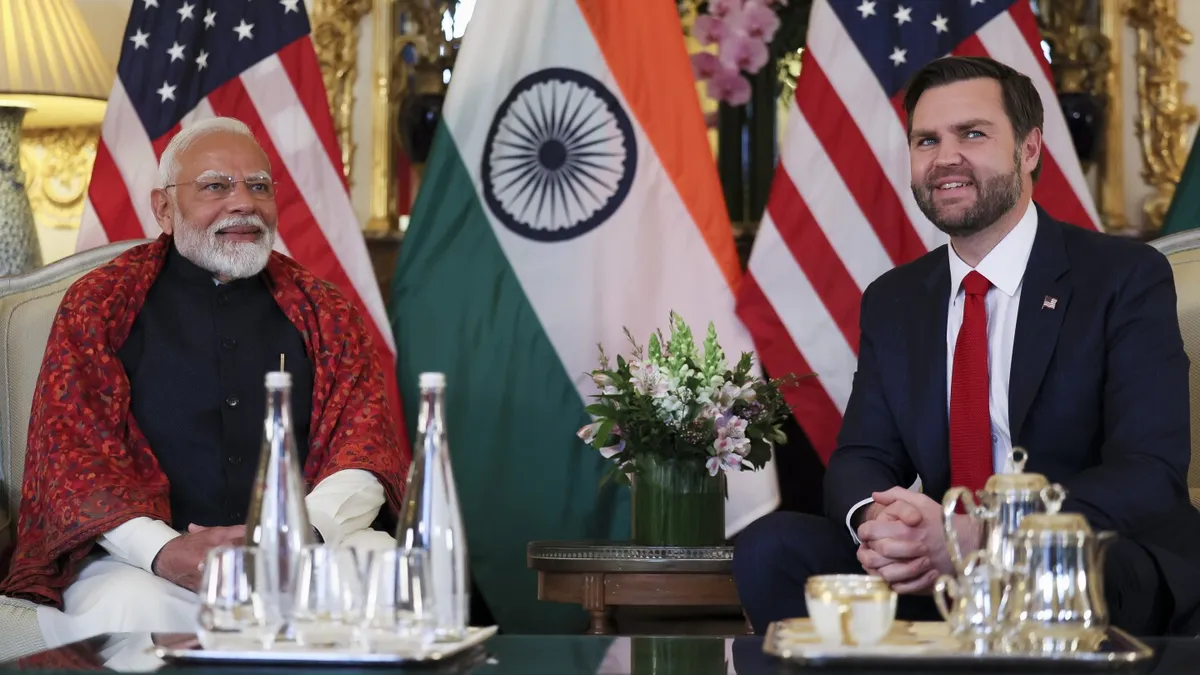
On Monday, U.S. Vice President JD Vance will commence a significant four-day visit to India, as both nations aim to unlock new economic opportunities and negotiate a crucial bilateral trade deal. During his trip, Vance is scheduled to meet with Indian Prime Minister Narendra Modi in New Delhi, where discussions will focus on enhancing economic ties, trade relations, and broader geopolitical connections.
This visit is perceived as a vital diplomatic mission by President Donald Trump’s administration, especially in light of the escalating trade war between the U.S. and China, India's main regional competitor. A successful trade deal between India and the U.S. could not only strengthen economic relations but also bolster diplomatic ties between the two countries. Currently, the U.S. stands as India’s largest trading partner, with bilateral trade valued at an impressive $190 billion.
India's foreign ministry has emphasized that Vance's visit will provide an opportunity to review the progress in bilateral relations. The two leaders are expected to exchange views on regional and global developments of mutual interest, paving the way for future collaborations.
Vance’s arrival in India follows closely on the heels of Director of National Intelligence Tulsi Gabbard's recent visit for a geopolitical conference and Prime Minister Modi's earlier meeting with Trump in Washington. Modi was among the first global leaders to engage in discussions with Trump after he took office. During that meeting, Modi highlighted the potential for a “mega partnership” with the U.S. and initiated negotiations to mitigate the impact of Trump's tariffs on Indian goods.
Despite the current pause on some tariffs, Trump has targeted India with a 26% levy, impacting Indian exporters. In response, Modi has expressed a willingness to reduce tariffs on U.S. goods further, repatriate undocumented Indian nationals, and purchase military equipment. Both countries are also gearing up to start formal talks aimed at finalizing the bilateral trade agreement.
India's partnership with the U.S. extends beyond trade; it encompasses foreign direct investments, defense cooperation, and strategic alliances aimed at countering China's growing influence in the Indo-Pacific region. India is a member of the Quad, a strategic alliance that includes the United States, Japan, and Australia, designed to serve as a counterbalance to Chinese expansion.
Leading U.S. corporations, including Apple Inc. and Google, have significantly expanded their operations in India. Recently, Elon Musk's Starlink signed agreements with two of India’s top telecom providers to introduce satellite-based internet services. In a bid to enhance trade ties, the U.S. and India have set an ambitious goal of more than doubling their bilateral trade to $500 billion by 2030.
The urgency of these negotiations is heightened for New Delhi, especially as it faces potential reciprocal tariffs from Trump that could heavily impact key sectors such as agriculture, processed food, auto components, high-end machinery, medical equipment, and jewelry. This situation presents a formidable challenge for Modi's government, which is aiming to invigorate the country’s economy and generate jobs through an export-led recovery.
Vice President Vance's visit marks his first official trip to India, carrying personal significance as well. His wife, Usha Vance, is a practicing Hindu and the daughter of Indian immigrants from South India. In his memoir, "Hillbilly Elegy," Vance describes his wife as a “supersmart daughter of Indian immigrants” whom he met at Yale Law School. Usha's parents immigrated to the U.S. in the late 1970s.
Accompanied by his wife, their children, and senior members of the U.S. administration, Vance will also explore Indian cities such as Jaipur and Agra, participating in engagements at various cultural sites, according to a recent White House statement. This visit is expected to not only strengthen political and economic ties but also foster deeper cultural connections between the two nations.